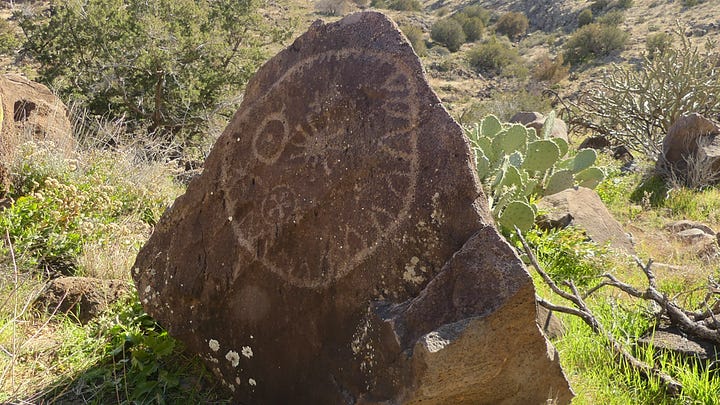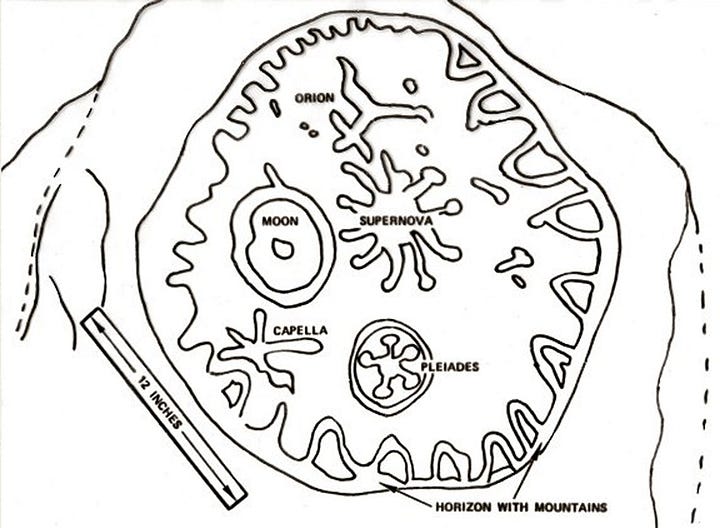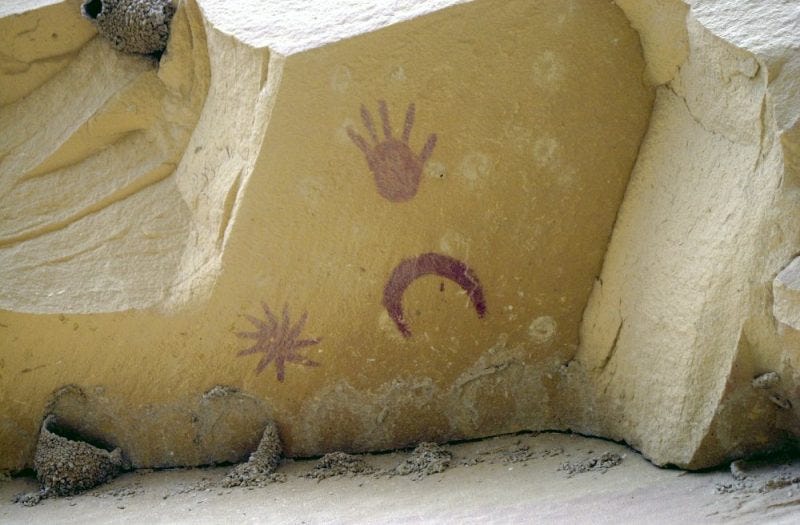Ancestral Puebloans Viewed the Supernova of 1054 CE
Did they leave a pictograph of the event in Chaco Canyon?
A pictograph painted on a rock located along the Peñasco Blanco trail in Chaco Culture National Historic Park may depict a star that exploded on July 5, 1054. The pictograph shows the waning moon and the exploding star. In addition, an adjacent pictograph may represent Halley’s Comet which appeared in 1066 CE (Common Era, formerly AD).
Last week’s post was about a petroglyph also in Chaco Canyon, New Mexico that was possibly the depiction of a total solar eclipse back in 1097 CE. The Ancestral Pueblo people studied the sun, moon and stars and recorded major events in both petroglyphs and pictographs on rock faces.
The depiction of the Supernova is a pictograph instead of a petroglyph like the eclipse depiction discussed last week. What’s the difference?
Rock Art - The Difference Between a Petroglyph and a Pictograph
Chaco Canyon is home to thousands of rock carvings and paintings. While they are sometimes called “rock art” others don’t believe that term captures the true significance of the images. There are two basic types: petroglyphs and pictographs.
The supernova image is a pictograph.
Petroglyphs were carved into rock faces using a variety of techniques. A striking stone can produce a visible indentation in the rock. In addition, the maker could scratch away the top of a weathered surface to reveal material of a different color underneath.
Pictographs were painted on cliff walls, often using yucca paintbrushes. Since they are a pigment of sorts coating the rock, they tend to be less durable than petroglyphs. Most of the surviving pictographs in the park are found in sheltered areas. Pigments were created using different compounds for different colors such as hematite for red, calcium carbonate for white, yellow ochre and turquoise.

What’s a Supernova?
A supernova is an extremely bright and powerful explosion of a dying, massive star that’s at least five times the mass of the sun, according to NASA’s definition.
When a massive star runs out of fuel, it cools off which causes the pressure to drop within the core. Gravity causes star to suddenly collapses. The explosion sends out a cloud of debris which forms a nebula.
The Supernova of 1054 CE
Chinese astronomers noticed the sudden appearance of a star blazing in the daytime sky on July 4, 1054. All of humanity with view of the northern sky likely saw what is now known by astronomers as SN1054.
In what is now New Mexico, SN1054 would have appeared in the constellation Taurus next to a waning crescent moon at sunrise on the day after the Chinese saw it: July 5. It was so bright that it could be seen during the day for 23 days and at night for almost two years.
So…Is That a Pictograph of a Supernova?
The time of SN1054’s explosion coincides with the height of Chacoan culture and there was a waning moon at sunrise. What do you think?
The Supernova Pictograph is on a shaded horizontal rock face 16 feet above the Peñasco Blanco trail. On the vertical rock face just under the supernova is a pictograph that may represent Halley’s Comet which passed overhead in 1066 CE. The comet pictograph is more exposed to the elements, has faded and is very difficult to see.

I think that it’s a strong possibility that the Ancestral Puebloans were recording a phenomenal sight there on the rock face. People who have encountered other rock art elsewhere (Arizona) think they have found a record of SN1054.
Another Prospective Supernova Petroglyph in Arizona
Last year I visited Agua Fria National Monument an undeveloped preserve managed by the Bureau of Land Management (BLM) approximately 60 miles north of Phoenix. The roads are not paved and the only place I was able to visit without four-wheel-drive was the unexcavated Pueblo la Plata (which was very interesting by-the-way).
I found a website called Desertlavender.com that says that a group of people have found what they think is a petroglyph of the same supernova event in 1054 CE. It must be located way out on those very difficult roads in the monument. Although this wasn’t published by a university like the other piece of rock art, the author did name the items on the petroglyph that makes good sense. What do you think?


Crab Nebula
As I mentioned previously, the cloud of debris matter that is ejected during a star exploding forms a nebula. The SN1054 was one of the most famous supernovae to be observed by humans and ultimately formed the Crab Nebula. It was the first astronomical object recognized as being connected to a supernova explosion in history. The nebula is located in the constellation Taurus (about 6500 light years from Earth).
You can still see the Crab Nebula today through binoculars or a telescope. This website has great instructions and more information about the nebula.
How to Visit
The Supernova Pictograph and adjacent Halley’s Comet Pictograph are located on Peñasco Blanco trail in Chaco Culture National Historic Park. Peñasco Blanco, an unexcavated great house and is 7.5 miles round trip. The Supernova Pictograph is approximately 0.8 mile before Peñasco Blanco. Hot temperatures in the summer and soft sand can make this a difficult trail.
In last week’s post, I discuss the challenging dirt roads out to Chaco Culture National Historical Park. Make sure you check out park alerts prior to visiting.
Next Time
There are so many interesting things at Chaco Canyon to explore. The final astronomical phenomena that I want to cover is one called the “Sun Dagger”. The phenomenon was “rediscovered” in 1977 by a volunteer who was recording petroglyphs. It is a solar calendar of sorts that indicates the solstices and equinoxes with a “dagger” of light shining on spiral petroglyphs. Be sure to check it out next week!










Jan, thanks for sharing this amazing place. I co-led a trip to Chaco in 2010, where we viewed the petroglyphs/pictographs you featured this week and last. It turns out that I didn't miss the Halley Comet pictograph, though I may not have known that it had that interpretation. I have unenhanced photos of it--apparent can't share them here. I never cease to wonder about the incredible ability and intelligence of those people a thousand years ago.
The pictograph photos are amazing!